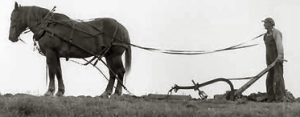Will Braddock, in Eagle Talons, The Iron Horse Chronicles–Book One, encountered sod houses on the Nebraska prairie during his first train ride on the Union Pacific. I described what Will saw from the open doorway of the boxcar in which he was riding. My inspiration for that scene is based upon a famous photograph of the Sylvester Rawding family “soddy” taken by Solomon D. Butcher.
[media-credit name=”Solomon D. Butcher” align=”aligncenter” width=”300″] [/media-credit]
[/media-credit]
In the photograph, you see the family members standing proudly in front of their home, with Mr. Rawding’s team of mules featured prominently alongside them. A family cow has managed to steal the show in the photo by grazing on the roof of the house. Will Braddock got a chuckle out of the cow’s antics.
The vast expanse of the western grasslands provided little in the way of timber for building houses. The cottonwood trees that grew along the streams were too crooked to yield timber in usable form. The homesteaders relied on the resource most readily available to them–the thick-rooted prairie grass. The settlers jokingly referred to the building material as “Nebraska marble.” Sod houses were not original to those settling the American west. Norsemen and other cultures had built homes in a similar fashion for hundreds of years.
 Farmers sometimes had to cut the tough prairie grass roots by hand; but, if they were fortunate enough to own one of the new “grasshopper” plows, they could more easily harvest the 2′ x 1′ x 6″ blocks of sod using horsepower. I can visualize that process, because as a boy growing up in the 1940s, I followed along beside by grandfather as he used a horse and plow to prepare his fields for planting corn and other crops. Although he was not “harvesting” sod, the plow still required muscle and skill to till the soil.
Farmers sometimes had to cut the tough prairie grass roots by hand; but, if they were fortunate enough to own one of the new “grasshopper” plows, they could more easily harvest the 2′ x 1′ x 6″ blocks of sod using horsepower. I can visualize that process, because as a boy growing up in the 1940s, I followed along beside by grandfather as he used a horse and plow to prepare his fields for planting corn and other crops. Although he was not “harvesting” sod, the plow still required muscle and skill to till the soil.
The typical sod house was a single room no bigger than 16 feet by 20 feet. The walls consisted of layers of sod “bricks.” The roof provided the biggest challenge to the builder. It might be formed by laying bundles of brush atop wooden cross poles, then topped with another layer of sod. During rainy periods, mud dripped onto the occupants, along with assorted creatures who lived in the sod, such as snakes. Still, the sod house provided an inexpensive method for quickly getting a family sheltered as they began their new lives. The homes were cool in the summer and warm in the winter. The thick, sod walls provided good insulation, even though they were frequently damp.

 RSS - Posts
RSS - Posts